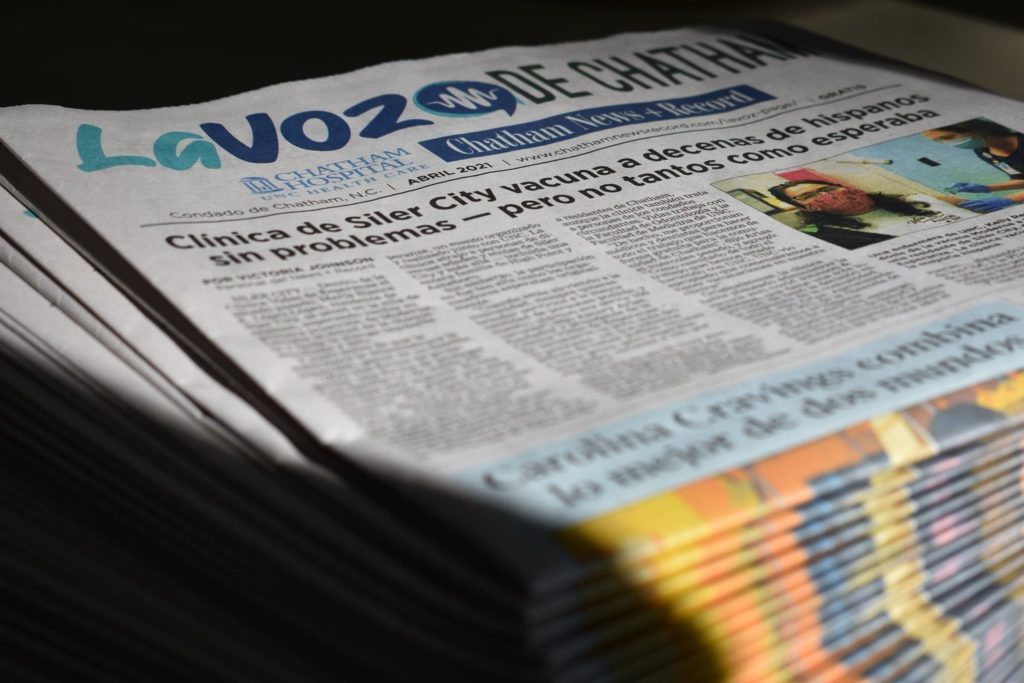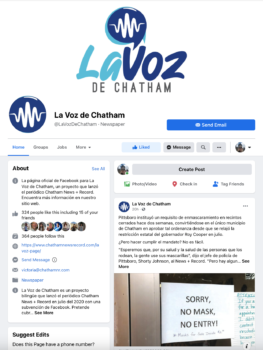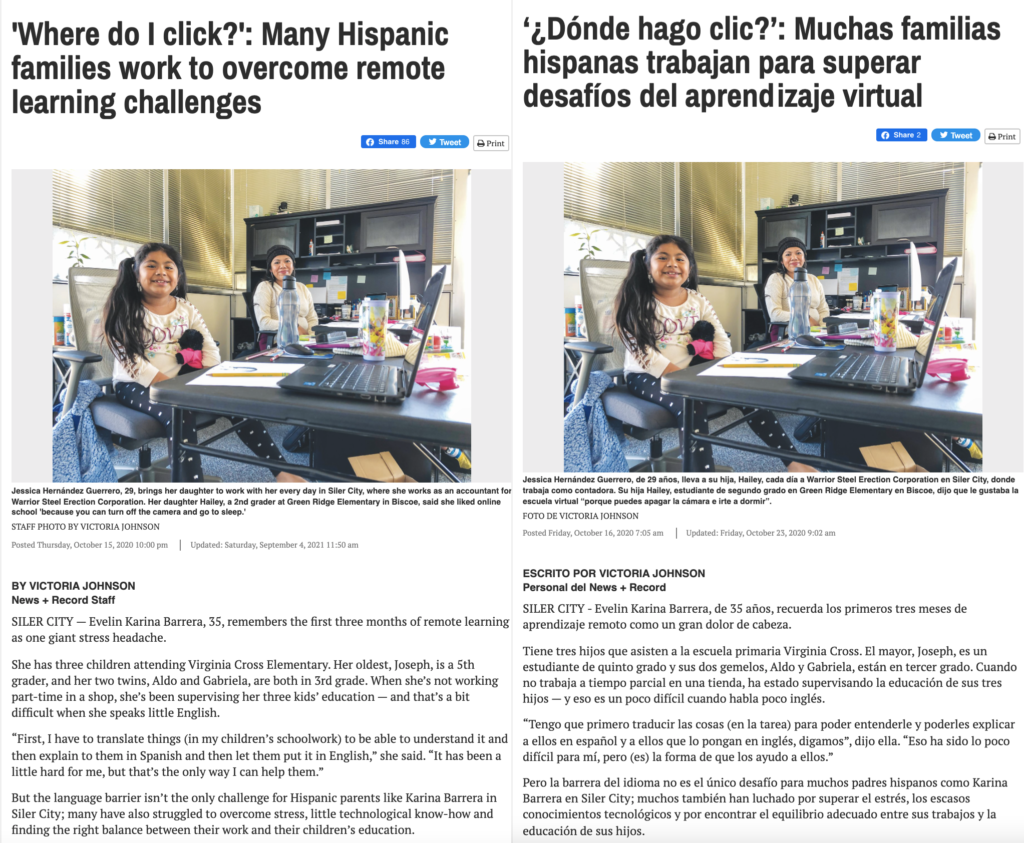How the Chatham News + Record is serving the Latinx community — and building a new audience
Bill Horner III and Victoria Johnson, Chatham News + Record,This is a series on Better News to a) showcase innovative/experimental ideas that emerge from the Knight-Lenfest Newsroom Initiative and b) share replicable tactics that benefit the news industry as a whole. This “win” comes from Bill Horner III, publisher and editor, and Victoria Johnson, lead La Voz de Chatham reporter, both at the Chatham News + Record in Siler City, N.C. The Chatham News + Record participated in the UNC Table Stakes program in 2020-21.
Question: What communities do you serve and what can you tell us about the history of your organization?
Answer: We’re a 143-year-old start-up. Kirk Bradley, Chris Ehrenfeld and Bill Horner III acquired The Chatham News and The Chatham Record from the Resch family in November 2018. Those newspapers date to the late 1870s. Our market is Chatham County, a rural but fast-growing county in central North Carolina.
When we bought the newspapers, we combined them (they were essentially one newspaper before, only with different front pages — one for the Siler City area, one for the Pittsboro area) and added a website and social media platforms. We doubled the local news coverage right away and worked to make the News + Record an essential part of the community.
We serve all of rural Chatham County and have some subscribers in neighboring counties, but our focus is on Chatham.

The Chatham News + Record published the first “La Voz” broadsheet newspaper in April. (Victoria Johnson/Chatham News + Record)
Q: What problem were you trying to solve, and why was solving the problem strategically important for your organization?
A: According to 2020 U.S. Census data, Chatham’s Hispanic/Latinx population is about 13.6% of the county’s population, or between 10,000 and 11,000 people — perhaps even more if we take into account the census’ pandemic-related reporting difficulties.
With La Voz, we were working to tell the previously untold stories of that population, particularly with regard to that group’s struggle with COVID-19 and the other difficulties of being a distinct, but growing, minority. The problem wasn’t just that the Latinx community didn’t have a dedicated local news source, but that the community as a whole was mostly disconnected from a large segment of its population. Chatham County has a diverse population, but that diversity isn’t just racial. It’s also relational.
By helping to tell and share those stories (beginning with the pandemic’s impact on people, families, Latinx-owned businesses, etc.), we were doing what good newsrooms do — reflect the communities they serve. But we also saw an opportunity for an audience segment we could add. If we did what we intended to do, and did it well, it could help us provide an entree into new potential audiences.
Q: How is this approach related to Table Stakes (e.g. one of the 7 Table Stakes and/or an outgrowth of the Knight-Lenfest initiative, etc.)?
A: This effort is related directly to Table Stake No. 1 (“Serve targeted audiences with targeted content.”).
The La Voz initiative requires a new skill development for us — reporting in a different language and working within a community largely previously ignored by the newspaper, and this work is helping us serve a targeted new audience. We felt it was an essential part of our mission anyway, but a byproduct of that also provided lots of opportunities to help us create sustainability.
Q: How did you go about solving the problem?
A: Initial funding from a Facebook Journalism Project COVID-19 Local News Relief Grant helped us get started. With that funding, we hired a Spanish-speaking reporter (Victoria Johnson) and a part-time native Spanish-speaking intern (Patsy Montesinos) and went about building relationships, asking questions and reporting about COVID’s impact. From there, we continued to work to build trust, to build relationships and sources, to ask questions and to tell stories.
We especially built relationships with organizations like the Hispanic Liaison, Chatham’s primary Hispanic advocacy nonprofit, and Communities in Schools of Chatham County — nonprofits directly working to solve the problems they’ve identified on the ground. These organizations and their staff connected us with not only people willing to tell their stories but other leaders among the county’s Spanish-speaking community. We have also worked with Hispanic churches in the area.
We didn’t — and don’t — always go through partnerships. For stories about the pandemic’s impact on businesses, churches and families, Victoria reached out directly — and many owners, pastors and community members were eager to share their stories. Sometimes, we found, you need only to ask.

The bilingual La Voz de Chatham page on Facebook has served as the primary source of news for many Spanish-speaking community members.
In the beginning, we set up a bilingual “La Voz” page on the CN+R’s website, with English- and Spanish-language stories displayed side-by-side. Beyond publishing stories for and about the county’s Hispanic community, we also began to translate any news — or even features and profiles — that we thought might be relevant, as well.
Based on what community organizations had told us, we chose to launch a bilingual La Voz de Chatham page on Facebook, which we were told was the primary source of news for many Spanish-speaking community members. We’ve got roughly 360 followers, and our story posts receive regular engagement, though perhaps not as much as we would like.
We initially planned a single, stand-alone print edition. But the response from that first “La Voz” broadsheet newspaper in April led us to decide to publish quarterly in print. We also transitioned to a tabloid section. For the September edition, we doubled our ad revenue and also our distribution — from 2,500 that first edition to 5,000 this time around. We hired additional interns to deliver to more drop-off locations. We know that a good segment of our audience trusts print better than digital, and the demand for print is definitely there.
Q: What worked?
A: Gradually, we grew an audience. We could see the appetite for content in print (in English, in our weekly editions of the News + Record), online (in Spanish, primarily through the La Voz tab on our website and our La Voz Facebook page) and then finally in print again, through our now-quarterly editions of La Voz de Chatham.
We also are steadily achieving what we’d set out to do: serve a historically underserved community. Many of our stories have left their mark, especially on the people whose voices La Voz amplifies.
In mid-August of 2020, we published a story about the acute pandemic-related challenges local Hispanic business owners faced. A few days later, Victoria received an email from one of the business owners she’d interviewed in Spanish: “GRACIAS. Dios le Bendiga!!! (THANK YOU. God bless you!!!)”
Likewise, after we published a story about the unique remote learning challenges Spanish-speaking parents faced in fall of 2020, one mother later passed along a brief message in Spanish: “Muchas gracias a ustedes que nos toman en cuenta (Thanks so much for taking our opinion into account).”

A story about remote learning was published in both English and Spanish on the Chatham News + Record’s website.
Q: What didn’t work?
A: The frequent La Voz stories alienated some long-time readers of our paper. Some readers who thought we were writing too much about the Hispanic community canceled subscriptions.
We’ve also had mixed success in getting support from some advertisers for the project. That part has gotten better as we’ve gone along, as noted by the doubling (from $3,400 to $6,800) in ad revenue from the first print edition to the second.
At the beginning, our community partners told us that short, engaging videos were one of the best ways to reach the Hispanic community in Chatham. That’s why we hired a part-time broadcast journalist (Patsy Montesinos, who was then a third-year journalism student at the University of North Carolina Hussman School of Journalism and Media).
She created a couple of videos for us in English and in Spanish — introducing local COVID-19 testing options, a Siler City immigrant who built a steel erection company from the ground up, plus another video about the sacrifices two immigrants made to put three children through college. Each proved to be popular among our growing audience at the time, but once she left, we unfortunately couldn’t sustain a video component.
Q: What happened that you didn’t expect?
A: We didn’t realize how long it would take to build trust among the Latinx population in Chatham County. We had a lot of help from the Hispanic Liaison and some leaders among the Spanish-speaking population in our market, but natural skepticism existed when we began the project. Some in the Latinx community have said they are hesitant to talk to the press; that was something we didn’t anticipate when we started.
COVID has made direct, personal connections in groups difficult, but before the pandemic, we included representatives from Chatham’s Latinx community as part of a series of “One Chatham” community conversations, including one event that focused on socio-economic inequality in Chatham County. We’d like to resume in-person events to leverage momentum from La Voz.
Q: What would you do differently now? What did you learn?
A: Put much more emphasis on trust-building (which would have been difficult; COVID was such a major problem and made it hard to meet face-to-face) and work to provide a printed edition earlier (our first one came nearly a year into the program). Holding small focus group meetings across the market would have helped, too.
As far as what we’ve learned: we’re still learning, refining. We don’t think we’re “there” yet in terms of reaching the potential of the kind of impactful reporting we can do, but we’ve done important work and have stories and series planned that will help us get there.
Q: What advice would you give to others who try to do this?
A: Do it. Design, do; then design and do again. Bill remembers that, 20 or 25 years ago, there was a lot of talk in the industry about how to serve the Spanish-speaking segments of our markets. Researchers published studies and people did a lot of talking at meetings, but very little doing ensued. Of course, you have to plan and think hard about what you’re trying to achieve — and how to make it pay for itself. But there’s an appetite for this kind of coverage from this kind of project.
Q: Is there anything else you’d like to add?
A: The initiative wouldn’t have worked nearly as well had it not been for Victoria Johnson. She’s not a native Spanish speaker but does speak the language, and she’s done some wonderful work for us and a lot of compelling reporting.
Lots of credit, too, goes to Patsy Montesinos for her work, particularly with doing translations. And we’ve just added Heidi Pérez-Moreno to the project as a part-timer, replacing Patsy (who’s just graduated from UNC-Chapel Hill). Heidi brings a lot of experience from her time at UNC — she is in her senior year there.
News as a commodity has value so long as it resonates in an audience. We don’t know what the future holds for La Voz, but it’s an integral part of our drive to sustainability.